Вы здесь
Zharkent Orthodox Church.
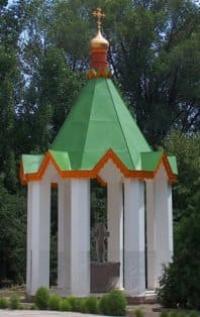
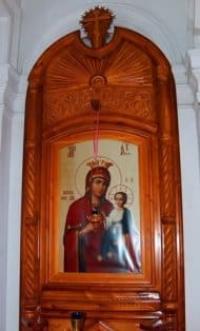
Orthodox monuments of Kazakhstan.
"The Russian faith was formed from the interaction of three forces: the Greek faith brought to us by the monks and priests of Byzantium, Slavic paganism, which met this new faith, and the Russian national character, which in its own way accepted Byzantine Orthodoxy and reworked it in its spirit."
Florensky P. A.
Excursion to Orthodox Church of Zharkent.
Zharkent Orthodox Church, located at an altitude of 633 meters above sea level, is located on Sh. Valikhanov Street, 109 between Turkebaev, Zhibek Zholy and Konaev Streets, in western part of town of Zharkent in Zhetysu region.
According to archival data, the issue of building a church in Zharkent was raised by the Cossacks on August 12, 1882, with the assistance of the clergyman Pavel Beloyarov, who headed the Orthodox Church in the city of Kuldzha (China). Beloyarov had 4,000 rubles in his account, and another 5,000 rubles were donated by the merchant Somov, but these funds were not enough, so the construction of the church was delayed.
Only in 1892, a Russian Orthodox church finally appeared in the city. The church building in Zharkent was built of wood (Tien Shan spruce) on a stone foundation, with external and internal plaster, covered with sheet iron, with several domes and a bell tower. During the Soviet hard times, the church was closed and used by local authorities for economic needs.
Only in 1991, the church was returned to believers. On May 17, 1992, exactly one hundred years after the construction of the church, priest Pavel Ivanov (now Hegumen Vianor) was appointed rector. The church was re-consecrated on July 26, 1994 by Archbishop Alexy of Almaty and Semipalatinsk.
The church contains the relics of the holy martyr Vasily (Kolmykov), priest of Jarkent, and other martyred Jarkent new martyrs, whose relics were uncovered on April 26, 2002, in the cemetery of the Podgornenskaya village (now the village of Kyrgyzai). Currently, the relics of the holy martyr Vasily, canonized in 2000 at the Jubilee Bishops' Council, and the 14 Orthodox Christians who suffered with him (not yet canonized, materials are being collected) are housed in a wooden carved reliquary with a canopy. An icon depicting all 15 martyrs was painted.
From 1956 to 1970, Archpriest Gregory (Wuhan), who suffered during the years of repression, served in the city of Panfilov (now Zharkent). The church has a small spiritual library, the collection of which is periodically replenished. Children studying in Sunday school and other parishioners regularly use spiritual literature. 35 children attend Sunday school, they study the Law of God and drawing.
It has become a tradition to hold a Christmas tree in the church with dramatizations, competitions, and a festive concert. Another tradition is visiting the border detachment, regiment and remote border posts in order to pastor the military personnel. After construction, this church was called a military church, since the builders were military. In the name of St. Nicholas (Nikolskaya). The church is wooden, on a wooden foundation and a brick base, cruciform with a central dome and four chapters on the sides. It was built and consecrated in 1899.
The building is covered with planks and painted with fawn paint, covered with iron. Inside, the church is plastered, decorated with stucco and whitewashed in a pale green color. The floor and ceiling are wooden. The church could accommodate up to 700 people. It was built under the supervision of engineer Nalikin. The church is a log building, richly decorated with carvings.
Relics of holy martyrs in Zharkent temple.
The relics of the holy martyr Vasily, priest of Zharkent, rest in the Holy Ilinsky temple in the city of Zharkent, Zhetysu region. Together with the relics of priest Vasily are the honest remains of 14 Orthodox Christians killed with him. The discovery of the holy relics took place on April 26, 2002, at the cemetery of the village of Podgornenskaya (now the village of Kyrgyzai) with the blessing of Archbishop Alexy of Astana and Alma-Ata (now Metropolitan of Tula and Efremovsky).
The relics are kept in a wooden carved reliquary with a canopy. An icon depicting all 15 martyrs is placed above the reliquary. Prayers are regularly held at the reliquary with the relics. Priest Vasily Kolmykov was born in 1866 to a merchant family. On January 2, 1913, he entered service in the Omsk diocese as a psalm-reader at the church in the village of Yuzhno-Podolsky, Tyukalinsky district.
On January 20 of the same year, he was ordained a deacon. From February 2, 1914, he served as a deacon in the church in the village of Chernovinsky, Zmeinogorsk district. On March 12, 1914, he was transferred to the church in the village of Chernoluchinsky, Tyukalinsky district.
In 1916, he was ordained a priest and appointed rector of the church in the village of Meshchansky, Zharkentsky district, Semirechye region. His parish also included residents of nearby resettlement settlements: Karkara, Vladislavskoye, Novo-Kievskoye and Okhotnichye. In July - September 1916, a Kyrgyz rebellion took place in Semirechye, which killed thousands of civilians.
Priest Vasily, saving his parishioners from the hands of the rebels, showed true heroism. After 1916, priest Vasily Kolmykov served in the Podgornenskaya village. The headman of the church in this village was a hereditary Cossack from the Omsk province, Zosima Funtikov.
A new Cossack village, called Podgornenskaya, was founded on the bank of the Kirgizsay River. Over time, fellow countrymen of the founders of the village began to move here and, when the settlement grew, the pious residents built a church in it.
The most respected person in the village, Zosima Funtikov, who was distinguished by his honesty, hard work and reverence for the Church of God, was elected church headman. The following custom, which Zosima and his wife adhered to upon reaching old age, speaks of his spiritual disposition.
Remembering death, Zosima prepared two coffins for himself and his wife, which stood in the attic of the house. Every autumn, having collected a new harvest, the couple filled these coffins with wheat, and having lived safely until Easter, they distributed this wheat to the poor residents of the village. Zosima also raised his children in the spirit of humility and the fulfillment of Christian commandments.
There is no information about the year in which the first church was built in the village of Podgornenskaya, and who was the first priest. It is only known that after the Kyrgyz rebellion of 1916, when an Orthodox church in the village of Meshchanskoye was desecrated and looted, houses were burned, and residents were evacuated, priest Vasily Kolmykov was transferred to a new place of service - to the village of Podgornenskaya in the Zharkent district. In 1918, when Bolshevik power was being established in Semirechye, a detachment of Red Army soldiers entered Podgornenskaya.
The commissars first arrested Father Vasily, then came to the church warden Zosima Funtikov and searched his home. They took the church wine and money, and arrested him. Then 13 more Orthodox Christians were arrested. They were all taken out of the village to the cemetery and shot with a machine gun.
Before the execution, the martyrs were beaten, some had sacks put over their heads. The Red Army soldiers did not allow the martyrs to be buried. They placed a machine gun on the mountain opposite the cemetery and did not allow anyone to approach the executed. At night, the villagers - Cossacks, among whom were Zosima's sons, secretly came to the cemetery and began to dig a common grave.
The machine gunner, hearing the sounds coming from the cemetery, would fire machine gun bursts from time to time, combing the cemetery and the surrounding area. Having dug a grave, the Cossacks placed priest Vasily, elder Zosima and 13 murdered villagers in it. For more than eight decades, local residents looked after the grave.
Over time, a small chapel was erected here, in which an ever-burning lamp burned. Often, especially on memorial days, their fellow countrymen would come to the grave of the martyrs, pray, and light candles. Despite the fact that during the Great Patriotic War, the chapel was dismantled for firewood by Uighur peasants who settled in this area (most of the Russians eventually left the former village and returned to Russia), the memory of the martyrs has survived to this day. Their grave, surrounded by a simple wooden fence and crowned with an old wooden cross, has remained a place of veneration for many years.
Priest Vasily was canonized as a new martyr and confessor of Russia for general church veneration in August 2000 at the Bishops' Council of the Russian Orthodox Church. Currently, materials are being collected for the canonization of 14 Orthodox Christians who suffered with him.
In the Ilyinsky Church there is an icon of St. Nicholas the Wonderworker, which belonged to the headman of the church in the village of Podgorny, Martyr Zosima (Funtikov), and was given to him on the day of the discovery of the holy relics by his granddaughter Vera Ignatyevna Starikova.
According to her, the holy martyr Vasily (Kolmykov) always prayed before this icon, and therefore Father Vasily's pectoral cross is embedded in the icon. The memory of the holy martyr Basil is September 16 (September 3, old style), as well as in the Councils of the New Martyrs and Confessors of Russia and the New Martyrs and Confessors of Kazakhstan.
Geographic coordinates of Zharkent Orthodox Church: N44°10'09 E79°59'47
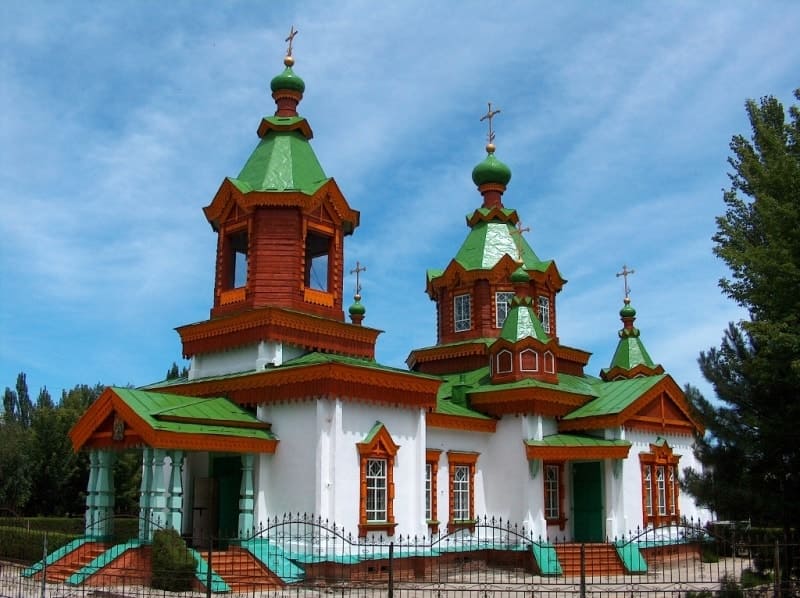
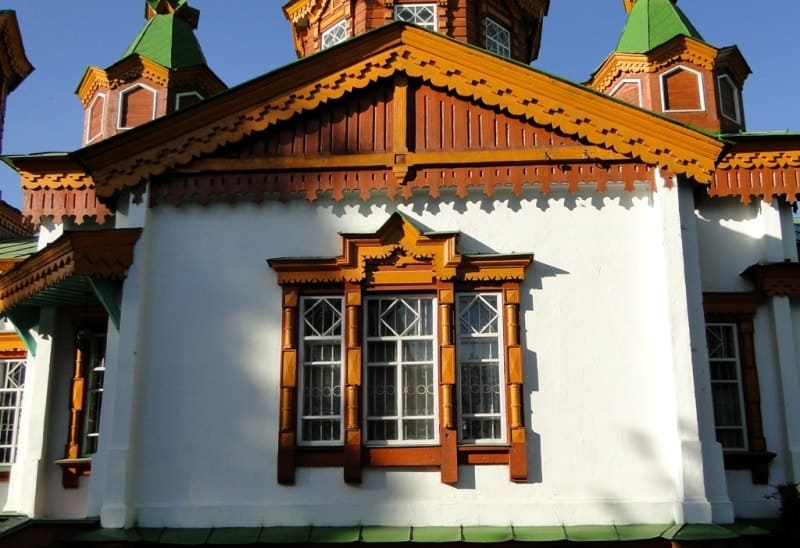
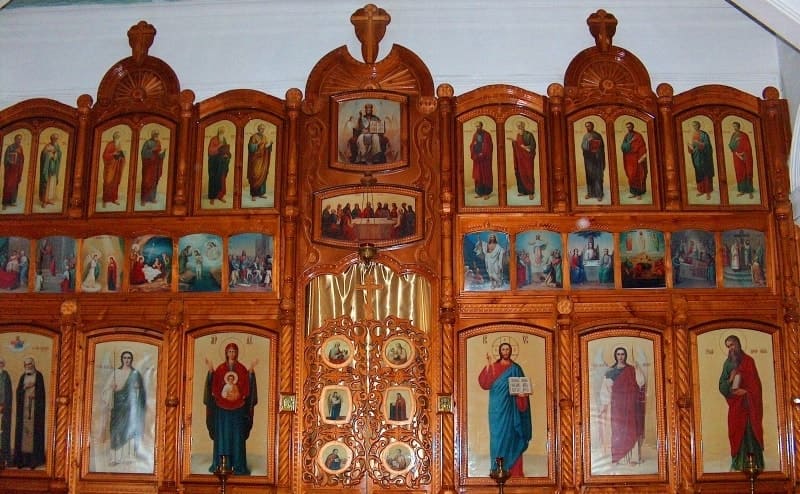
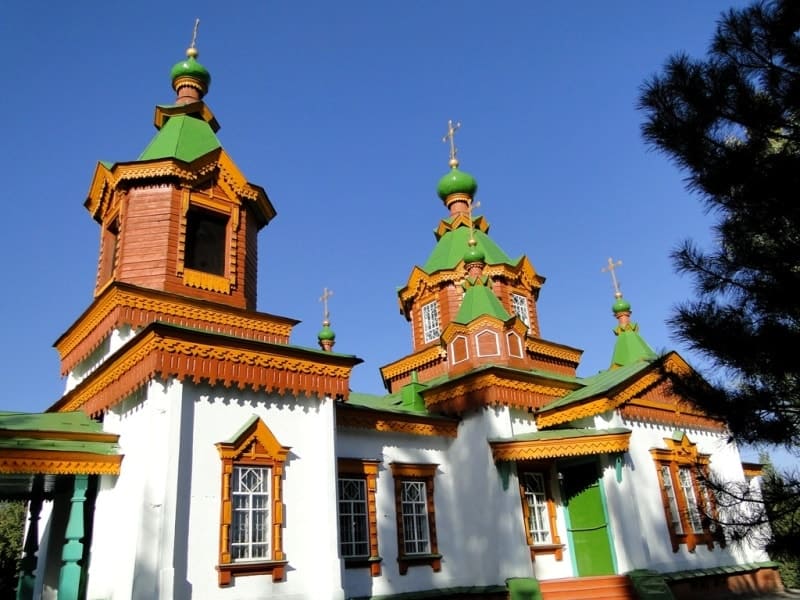
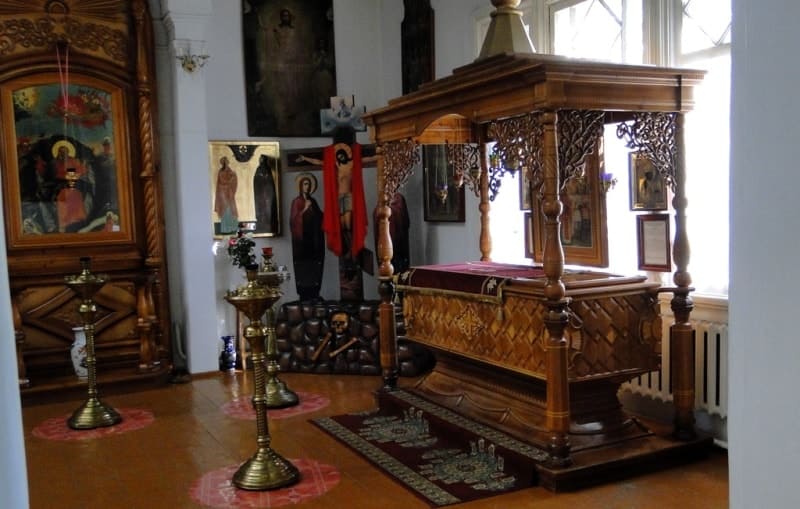
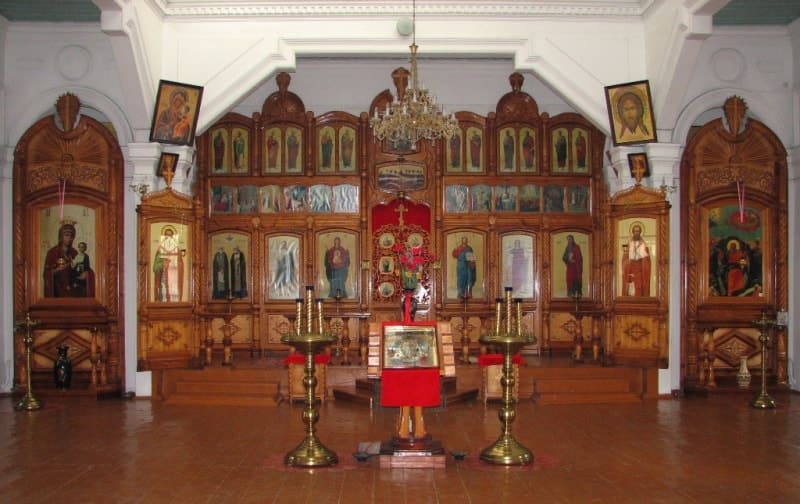
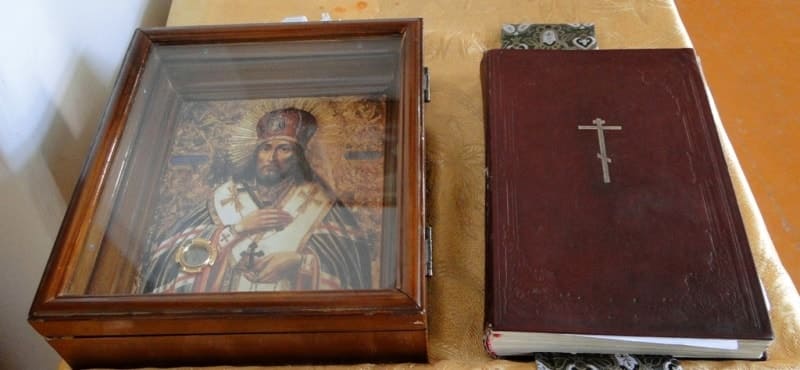
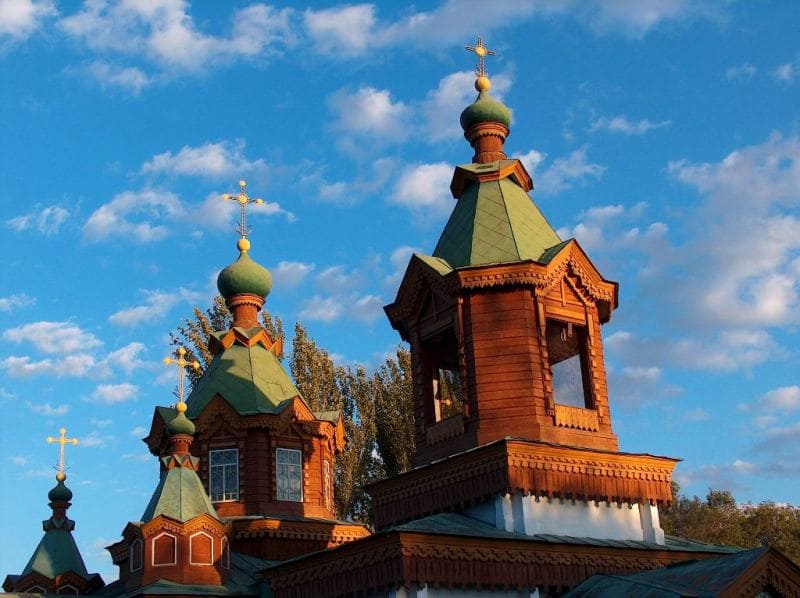
Authority:
A small part of the information was used from the book "The City of Verny and the Semirechensk Region" 2009, author A.G. Lukhtanov. The other part of the information was collected from various sources by A. Petrov. http://mitropolia.kz
Photos by:
Alexander Petrov.







